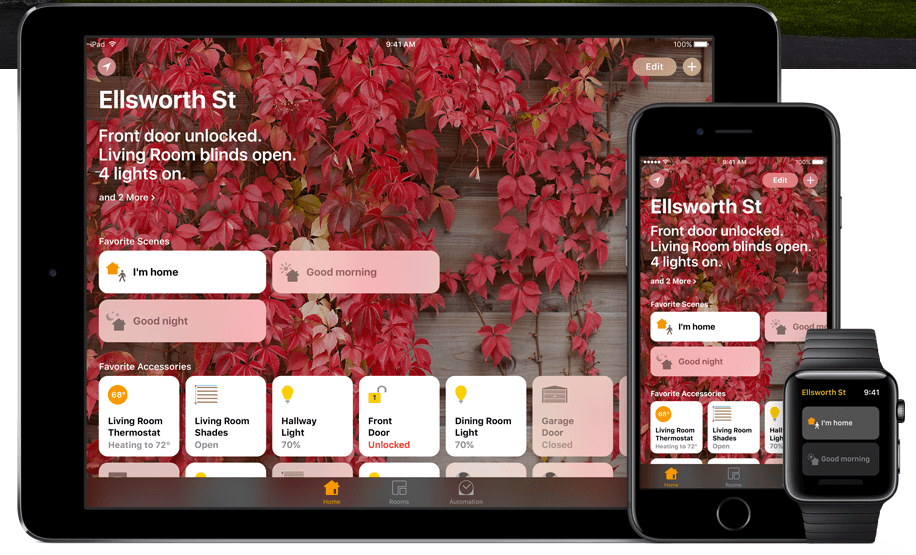
By Emma Bailey
The arrival of iOS 10 officially introduced Apple’s hotly-anticipated HomeKit platform app, with an aim to uncomplicate home automation once and for all. With the new Home app “baked in," iOS 10 confirms this platform is -- by company standards -- finally ready for primetime, after over two years of patient waiting and promises from Cupertino.
For developers and manufacturers, the Home app may seem to be a revelation. In the words of Apple, it is a "robust framework" and a "common protocol" that finally allows all HomeKit-enabled products to work seamlessly with iOS running on an iPhone or iPad. Now built into the iOS Control Center, there is support for new types of devices, including home security cameras, doorbells and air conditioning units. HomeKit-compatible products can now also be controlled through iOS 10's new interactive notifications.
Apple's arrival in home automation
When Apple debuted its HomeKit architecture in 2014, it seemed as though the tech behemoth was finally going to “lay down the law”and drive the adoption of uniform standards for mass consumption. However, a few key problems with Apple's approach remained: The user still had to control each product via individual, third-party apps, and at launch, only a few manufacturers supported HomeKit. At that time, Apple, far from achieving any unity or simplicity in the smart-home space, merely added its presence to the already crowded market.Apple has long been at the helm of the world’s technological progress. It was the first generation iPod that truly drove digital media players towards ubiquity. And indeed, Apple has also managed to corner the global smartphone market with it’s simple, stylish interface for uncomplicated -- not to mention irresistible -- usability. The company remains the world's largest seller of smartphone devices.
The home automation market, however, has proven to be a much different story. There are many barriers preventing mass-market smart home tech adoption, but the “technological fragmentation of the smarthome ecosystem” remains the largest obstacle between the early-adopter phase and the mass-market phase, in which manufacturers are capable of proving a need for their devices.
Cracking the competition
Thermostats that automatically regulate temperatures, door locks that you can operate remotely, and similar wonders of an “automatic” home offer endless opportunities for convenience. But the wow factor lessens considerably when you have to learn a new interface and control scheme for each and every device. Fluid, harmonious functionality is dependent upon multiple pieces of hardware working in tandem to make life easier. This can't happen if every device operates in isolation and can't interface with its peers.With the release of the Home app, Apple comes closer to remedying many of these issues. If a smart appliance says, "Works With Apple HomeKit," users should be able to connect it to the new app, and easily check it while at home or away. From the platform users simply set up “scenes” that consist of different configurations of the home environment, and can switch between them easily. To better compete with Amazon, and Google's similar device called "Google Home," Apple has also opened up Siri to outside developers, enabling voice recognition and control of smart home products that work with the Apple Home ecosystem.
Connecting to consumers
Cupertino is thus gathering strength to become more than just a comprehensive resource for consumers who have stuck it through as smart home early-adopters. By installing the Home app on everyone’s phone - all iPhone users who upgrade to iOS 10 will have no choice in the matter -- Apple undoubtedly sees the potential of a larger victory, turning the tide towards achieving ultimate victory in the ruthlessly competitive connected home market. For the millions of loyal Apple users internationally, the presence and convenience of smart home machinery may begin to seem quite tempting, if not totally necessary.Critics within the industry have speculated that the company purposefully delayed the introduction of the Home app for a couple of years to give developers time to make their offerings compatible with HomeKit, before launching a completely consumer-centric interface.Still, the platform has its limitations, leaving room for persistent, reasonable doubts. Siri has a lot of catching up to do (lagging behind Amazon's Alexa and other voice-enabled products), and the HomeKit platform's list of possible smart product integrations is shorter than what we see from competitors (such as Nest, Samsung's SmartThings and Wink).
With many other tech builders so firmly planted in the interconnected home-object arena, the function and meaning of Apple's Home system relies upon a profoundly loyal and committed consumer base. The company's heritage is its biggest advantage - by allowing the hugely successfully iPhone and iPad to work as comprehensive remote controls, the Home app could finally be the stepping stone needed to encourage a broad shift in the public's attitude towards smart home services and applications.
Image courtesy of Apple
Emma Bailey is a freelance writer and blogger from the Midwest. After going to college in Florida she relocated to Chicago, where she now lives with a roommate and two rabbits. She covers current topics in technology and issues pertaining to the environment.
TriplePundit has published articles from over 1000 contributors. If you'd like to be a guest author, please get in touch!














